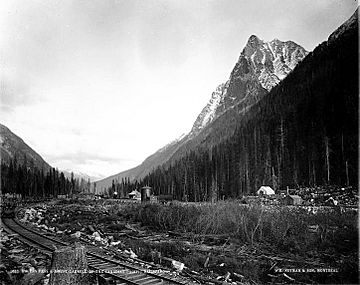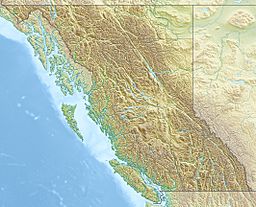Mount Macdonald facts for kids
Quick facts for kids Mount Macdonald |
|
|---|---|

Rogers Pass and Mount Macdonald (then Mount Carroll) on the Canadian Pacific Railway, 1887
|
|
| Highest point | |
| Elevation | 2,883 m (9,459 ft) |
| Prominence | 518 m (1,699 ft) |
| Parent peak | Uto Peak |
| Geography | |
| Parent range | Selkirk Mountains |
| Topo map | NTS 82N/06 |
| Climbing | |
| First ascent | 1886 by DO Lewis and several members of CPR Engineering |
Mount Macdonald is a tall mountain peak found in British Columbia, Canada. It's part of the Selkirk Mountains. This mountain stands right next to Rogers Pass in Glacier National Park. Mount Macdonald is well-known because of two very long railway tunnels that go through it. These tunnels are used by the Canadian Pacific Railway.
Contents
Mount Macdonald: A Giant Peak
Mount Macdonald reaches a height of 2,883 meters (about 9,459 feet). It's a significant peak in the Selkirk Mountains. The mountain is located in a beautiful area of Canada.
Tunnels Through the Mountain
Mount Macdonald is home to two important railway tunnels. These tunnels help trains travel through the rugged mountains.
- The first tunnel is called the Connaught Tunnel.
- The second, and even longer, tunnel is the Mount Macdonald Tunnel.
The Mount Macdonald Tunnel is super long! It stretches for 14.7 kilometers (about 9.1 miles). This makes it the longest railway tunnel in the entire western hemisphere. Imagine a train traveling that far underground!
How Did it Get its Name?
Mount Macdonald wasn't always called that. Its first name was Mount Carroll. This name honored a member of the CPR engineering team. That team was led by A. B. Rogers.
But in 1887, the mountain's name was changed. It was renamed to honor Sir John A. Macdonald. He was the very first Prime Minister of Canada. A Prime Minister is the main leader of a country's government. The change was made official by a special government order.
Weather on the Mountain
Mount Macdonald is in a subarctic climate zone. This means it has very cold and snowy winters. Summers are usually mild. Temperatures can drop below -20 °C (which is -4 °F). With the wind chill, it can feel even colder, sometimes below -30 °C (-22 °F).
Snow and rain that fall on the mountain eventually flow into the Beaver River. This river is a tributary, meaning it flows into a larger river, the Columbia River.
See also
 In Spanish: Monte Macdonald para niños
In Spanish: Monte Macdonald para niños


